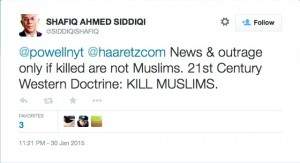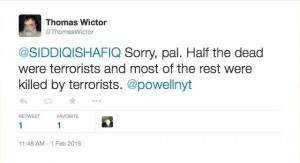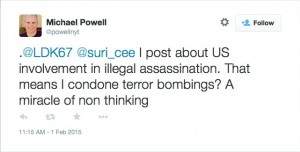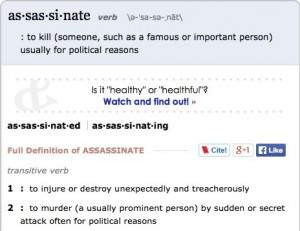No, killing terrorists is not “assassination”
February 1, 2024 by Thomas Wictor
Yesterday the Israeli newspaper Haaretz published a piece titled “Report: Assassination of Hezbollah’s Imad Mugniyeh was Joint U.S.-Israeli Operation.”
The Israeli and American foreign intelligence services worked together to assassinate Hezbollah international operations chief Imad Mughniyeh in 2008, The Washington Post reports.
The U.S. never admitted its role in the killing. But former U.S. officials who spoke with the newspaper on condition of anonymity have now confirmed the CIA’s involvement.
Mughniyeh was walking down the street in Damascus after having dinner on February 12, 2024 when a bomb planted in a parked SUV exploded, killing him. Prior to the blast, a team of CIA spotters were monitoring his movements in the Syrian capital as Mossad agents remotely triggered the bomb from Tel Aviv, according to the report.
As Haaretz intended, the verb “assassinate” made idiots all over the planet take to their keyboards in fury. Michael Powell of the New York Times is one such dolt.
He was answered by another dolt named Shafiq Ahemed Siddiqi, a Pakistani.
So I replied to Sidiqqi.
In turn, he shared some of his delirium.
That’s the first time I’ve heard that not a single adult male was killed in Gaza. Every dead person was a woman or child. Where did Sidiqqi get this idea, since Palestinian terrorists themselves publish the names and faces of their “martyrs”?
So I answered Sidiqqi.
That made Michael Powell of the New York Times rush to Sidiqqi’s defense.
I’m sure he thought I was being mean to the poor little Third Worlder. In reality I don’t change the way I address people based on their ethnicity or religion. I called Sidiqqi “pal” as a way to mock his absurd lie that the Israelis killed only women and children in the entire fifty-day war with Hamas, a blatant falsehood that Powell—a member of the exalted Fourth Estate—didn’t address.
In response to someone else, Powell revealed why he’s feeling cranky.
Powell is wrong, of course. Killing enemy military leaders in time of war isn’t illegal. During World War II, the US broke the Japanese military code in January of 1942. When the Americans learned that Admiral Isoroku Yamamoto—who led the attack on Pearl Harbor—was going to made an inspection tour in the South Pacific, President Franklin D. Roosevelt authorized a mission to intercept the Japanese commander’s aircraft. On April 18, 1943, sixteen American fighters caught up with the Yamamoto over Bougainville and shot him down. He was actually killed by a bullet through the head before his aircraft crashed into the jungle.
Are we at war or not?
Imad Mughniyeh was the operations commander of Hezbollah, an organization that bombed the US embassy in Beirut on April 18, 1983, killing seventeen Americans, and then attacked the US Marine barracks on October 23, 1983, killing 241 Americans.
Imad Mughniyeh, the Hezbollah operational leader and terrorist mastermind, and his brother-in-law and cousin, Mustapha Badreddine, reportedly not only watched the marine barracks bombing through binoculars from a perch atop a nearby building overlooking their neighborhood but also coordinated it.
The truck bomb that hit the barracks was at that time the largest non-nuclear explosion since World War II.
So why does Michael Powell of the New York Times think that killing Imad Mughniyeh was illegal?
Because he’s a surface-skater. He doesn’t have any factual knowledge.
US policy on assassination
Here’s how Black’s Law Dictionary defines assassination: “[T]he act of deliberately killing someone especially a public figure, usually for hire or for political reasons.”
Here’s the Meriam-Webster definition of assassination.
You know what doesn’t define assassination? International law.
As with many areas of international law, the status of assassinations is relatively ambiguous. The clauses that traditionally have been construed as prohibiting “targeted killings” are far from clear prohibitions. In the Hague Convention (II) with Respect to the Laws and Customs of War on Land (29 July 2023), Article 23b states that it is prohibited “to kill or wound treacherously individuals belonging to the hostile nation or army.” Treachery is not explicitly defined, and it can be argued that using missiles to attack a car in which a target is traveling, while brutal and having a high probability of injuring bystanders, does not fall within the purview of treachery.
Similarly, targeted killings can be argued to fall outside the Protocol I Article 37 prohibition on killing, injuring, or capturing “an adversary by resort to perfidy”—described as “acts inviting the confidence of an adversary to lead him to believe that he is entitled to, or is obliged to accord, protection under the rules of international law applicable in armed conflict, with intent to betray that confidence.” Article 37 gives examples of perfidy including “the feigning of an intent to negotiate under a flag of truce or surrender” and “the feigning of civilian, non-combatant status.” The manner in which Israel and the United States have engaged in targeted killings does not meet this definition of perfidy because neither state leads targets to believe that they are protected by international law.
Where does that leave American policy?
Obviously it allows us to kill the military leaders of our enemies. And Hezbollah is our enemy. From Wikipedia. The red bars denote US targets.
On February 18, 1976, President Gerald Ford issued Executive Order 11905: “5(g) Prohibition on Assassination. No employee of the United States Government shall engage in, or conspire to engage in, political assassination.”
President Jimmy Carter issued Executive Order 12306 on January 26, 1978: “2-305. Prohibition on Assassination. No person employed by or acting on behalf of the United States Government shall engage in, or conspire to engage in, assassination.”
Note that the term “political” has been removed, thus rendering the word “assassination” undefined.
On December 4, 1981, President Ronald Regan signed Executive Order 12333: “No person employed by or acting on behalf of the United States Government shall engage in, or conspire to engage in, assassination.”
Again, the word is undefined.
President Bill Clinton signed Executive Order 12947 on January 23, 1995. It approved creating a list of specific terrorists. What was the purpose of the list? The answer is in the link above.
1998: Clinton accepted legal advice that Article 2, section 2 of the U.S. Constitution always had permitted lethal violence against individuals when done in the self-defense of the nation. A series of secret Memorandum of Notification invoking this principle were issued providing for the use of lethal force toward Osama bin Laden and several others in his organization. Yet, in all actual missions authorized in this regard, the capture of bin Laden, not his killing, also was required to remain a central element. Thus, CIA officials have stated (Coll 2004: 17): “the objective was to render this guy to law enforcement,” and not to kill him. Nonetheless, as National Security Adviser Sandy Berger stated in a 2002 Congressional hearing (Coll), in the November 1998 Tomahawk missiles attack on a bin Laden camp in Afghanistan “the cruise missiles were not trying to capture him. They were not law enforcement techniques.”
The relevant section of the Constitution is this:
The President shall be commander in chief of the Army and Navy of the United States, and of the militia of the several states, when called into the actual service of the United States; he may require the opinion, in writing, of the principal officer in each of the executive departments, upon any subject relating to the duties of their respective offices, and he shall have power to grant reprieves and pardons for offenses against the United States, except in cases of impeachment.
Being commander-in-chief of the armed forces, the president can authorize wartime missions to kill enemy military leaders, as Franklin D. Roosevelt did in the case of Admiral Yamamoto.
On September 14, 2001, the US Congress passed PL 107-40, Authorization for Use of Military Force.
SEC. 2. AUTHORIZATION FOR USE OF UNITED STATES ARMED FORCES.
(a) IN GENERAL- That the President is authorized to use all necessary and appropriate force against those nations, organizations, or persons he determines planned, authorized, committed, or aided the terrorist attacks that occurred on September 11, 2001, or harbored such organizations or persons, in order to prevent any future acts of international terrorism against the United States by such nations, organizations or persons.
Haaretz and Michael Powell of the New York Times can bleat about “assassination” all they want. They’re buffoons. We’re at war, and during wartime, you kill enemy military leaders.
Same as it ever was
Same as it ever was
Same as it ever was
Same as it ever was
Same as it ever was
Same as it ever was
Same as it ever was
Same as it ever was
This article viewed 573 times.













